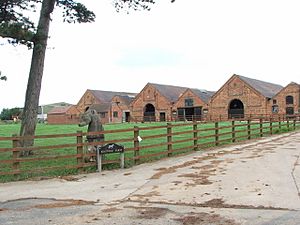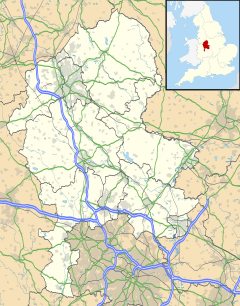Statfold facts for kids
Quick facts for kids Statfold |
|
|---|---|
 Statfold Farm |
|
| OS grid reference | SK237072 |
| Civil parish |
|
| District |
|
| Shire county | |
| Region | |
| Country | England |
| Sovereign state | United Kingdom |
| Post town | TAMWORTH |
| Postcode district | B79 0 |
| Dialling code | 01827 |
| Police | Staffordshire |
| Fire | Staffordshire |
| Ambulance | West Midlands |
| EU Parliament | West Midlands |
| UK Parliament |
|
Statfold is a small, historic area in Staffordshire, England. It used to be a village and its own local area, called a civil parish. Now, it's part of a nearby area called Thorpe Constantine.
Statfold is about 3 miles (5 km) north-east of Tamworth. Not much of the old village remains today. However, you can still find the old Norman church and the Tudor manor house called Statfold Hall. There are also a few farms and houses scattered around. In 1931, only 55 people lived in the parish.
The Statfold Barn Railway is a fun, narrow-gauge railway. It is located across the Ashby Road, in the Tamworth area.
History of Statfold
The name "Statfold" likely comes from an old English phrase, stōd fald. This means "stud fold," which is a place where horses are kept for breeding. Older records sometimes spelled the name Stotfold.
Statfold isn't mentioned in the famous Domesday Book. This book was a huge survey of England made in 1086. However, Statfold does appear in records from the 12th century. These records are from Lichfield Cathedral. It's possible Statfold was one of the unnamed estates belonging to the church mentioned in the Domesday Book. Today, Statfold Farm still continues the tradition of keeping horses.
The church in Statfold has a long history, going back to the 12th century. It was once an important part of the Lichfield Cathedral area. For many years, the church was supported by special church officials called "prebendaries." The last prebendary died in 1803. Later, the church became part of the parish of St Andrew Clifton Campville.
For local government, Statfold became part of the Tamworth Poor Law Union in 1836. This was a system to help poor people. In 1894, it became a civil parish within the Tamworth Rural District. This changed in 1934, when Statfold civil parish joined Thorpe Constantine. It then became part of the Lichfield Rural District.
Today, you won't see clear signs of the old village center. Some people think it was just north of the chapel. It might have been abandoned when the land was enclosed in the early Tudor Period. By 1851, only 45 people lived there. They lived in the Hall or in five other houses. In 1870, the population was listed as 26 people. They lived on about 450 acres (182 hectares) of land.
Important Places to See
Statfold Hall
Statfold Hall is a large, old house made of brick. It was built in 1571. This manor house is a Grade II listed building. This means it's an important historic building. The Wolferstan family has owned the manor since 1590. They got it when Humphrey Wolferstan married Katherine, who was the heir to the Stanley family, in 1565.
Most of the building you see today was built around the year 1700.
Chapel of All Saints
The old Chapel of All Saints is a Grade II* listed building. This means it's a very important historic building. It stands on the grounds of Statfold Hall. For many years, it was used as a special chapel for the Wolferstan family. It was a place where they held funeral services.
In 1851, the chapel was described as "neglected." The area was too small to have its own minister. The chapel was fixed up and used as a parish church again in 1906. Today, it is a private chapel. It is not open to the public.
The building is simple, with one room and a pointed roof. The church has features of Norman architecture. This includes rounded archways, which are typical of buildings from the 12th century. The oldest parts are the west doorway and the font (a basin for baptism). Both date back to the 12th century. Other parts have been changed over the centuries, especially in the early 14th century. Some parts might even be from the Anglo-Saxon period, which was before the Normans.
Outside the chapel, you can find the Wolferstan Memorial. This is also a listed monument.


